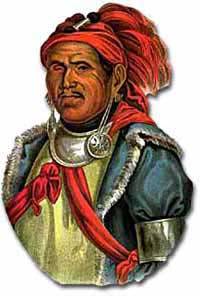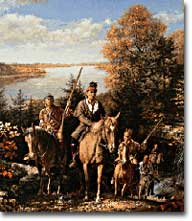21d. Native American Resistance in the Trans-Appalachian West

Tenskwatawa, also known as Prophet (pictured here), worked with his brother Tecumseh to create a broad-based tribal coalition which would resist American encroachment from the east.
In the 16th, 17th, and 18th centuries, the first white settlers in America inhabited the eastern seaboard. There the whites either made treaties with the Native American groups to buy land or they forcibly took Indian land. By the Revolution's end and on into the early 19th century, Native Americans were being displaced across the Appalachians and toward what is today the Midwest. For these exiled groups, there were few places left to go.
Outright military conflict with native groups in the northwest preceded the formal declaration of war in 1812. In fact, the "western war" in many ways represented a continuation of the American Revolution with many autonomous Indian nations again choosing to ally with the British against Americans who fundamentally threatened their survival.
The American invasion from the east deeply disrupted native groups and generally caused a sharp division within Indian nations between "accommodationists," who chose to adopt some Euro-American ways versus "traditionalists," who called for native purity by rejecting contact with whites. Both sides were authentically Native American, but they each chose different routes to deal with a terrible situation.
Tecumseh and Tenskwatawa, Shawnee brothers, were leading Indian traditionalists, and together they crafted a novel resurgence among native peoples in the west. Tecumseh, a political and military leader, is the better known of the two, but it was their combined skills that made them especially powerful. Tecumseh had fought at Fallen Timbers in 1794, but refused to participate in the peace negotiations that produced the Treaty of Grenville the following year. Instead, he removed to east-central Indiana where he led a band of militant young warriors.

Tecumseh traveled to Tukabatchi, the capital of the Creek people, to try to recruit Natives to join the Indian Confederacy, but he was met with resistance. Legend has it that he said he would return home to Ohio and stamp his foot with such force, they would feel the earth move in Tukabatchi. Several days after he left, a small earthquake did hit the Creek Capital.
His younger brother Tenskwatawa provided the essential vision to launch a much broader Indian social movement. Also known as the Prophet, Tenskwatawa combined traditional native beliefs with some aspects of Christianity to call for a pan-Indian resistance against American intruders from the east. He explained that when native peoples joined together and rejected all contact with Americans and their ways (from alcohol to private property), God would restore Indian power by "overturning the land so that all the white people will be covered and you alone shall inhabit the land."
Tecumseh gradually converted to the Prophet's vision and together they built a broad movement that revived the Western Confederacy of the 1790s and even reached out to southern tribes with stronger accommodationist factions. In 1808 they founded Prophetstown at the sacred junction of the Tippecanoe and Wabash Rivers, from which they built a strong Indian alliance that directly challenged the U.S. government.
This growing Indian force threatened American plans to move west and seemed especially dangerous since it received economic and military support from the British in Canada. In November 1811 the U.S. destroyed Prophetstown during the Battle of Tippecanoe, under the leadership of future president William Henry Harrison. Tecumseh was away at the time recruiting southern Creeks to the confederacy.

This view of Fort Niagara, with Native Americans in the foreground, was drawn by James Peachy in 1783.
Tecumseh's successful military resistance continued and threatened white settlements throughout the northwest. Tecumseh had so profoundly challenged U.S. plans in the northwest that when he was finally killed at the Battle of the Thames in October 1813 it was seen as a major American victory even though it meant quite little strategically.






